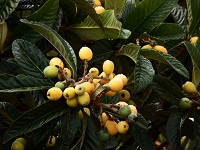Leaf and branch extracts of Eriobotrya japonica exert antibacterial activity against ESBL-producing Escherichia coli and Klebsiella pneumoniae
Keywords:
Eriobotrya japonica, Extended Spectrum Beta Lacatamase, Minimum Inhibitory Concentration, medicinal herbsAbstract
In this study, the antimicrobial activity of leaves and branches of Eriobotrya japonica, a Lebanese endegenious plant, against Extended Spectrum Beta Lactamase -producing Escherichia coli and Klebsiella pneumoniae was determined and the specific plant fraction responsible for this antimicrobial activity were identified. The plants were extracted with ethanol to yield the crude extract which was further subfractionated by different solvents to obtain the petroleum ether, the dichloromethane, the ethyl acetate and the aqueous fractions. The Minimum Inhibitory Concentrations (MIC) and Minimum Bactericidal Concentrations (MBC) were determined using broth microdilution. Both inhibitory and bactericidal effects of Eriobotrya japonica on Escherichia coli and Klebsiella pneumoniae were mainly observed with the crude extract of the plant, the ethyl acetate, the Dichloromethane, and the aqueous fractions. The antibacterial effect of the Petroleum ether fraction was limited with the leaf extract; however, it was acceptable with the branch extract. The lowest MIC90 was observed with ethyl acetate fraction for both leaf and branch extracts with Escherichia coli and Klebsiella pneumoniae. The concentrations at which most of strains were inhibited ranged between 40 μg/μl and 80 μg/μl. MICs and MBCs effects were detected within 1 dilution. This study constitutes a good example for the screening of antimicrobial activities of plants on highly resistant organisms of clinical importance; however, toxicity of these extracts needs more investigation.
References
Sharma R, Sharma C, Kapoor B. Antibacterial
resistance: current problems and possible
solutions. Indian Journal of Medical Sciences.
;59(3):120-129.
Moubareck C, Doucet-Populaire F, Hamze M,
Daoud Z, Weill F.X. First extended-spectrumbeta-lactamase (CTX-M-15)-producing
Salmonella enterica serotype typhimurium
isolate identified in Lebanon. Antimicrobial
Agents and Chemotherapy. 2005;49(2):864-
Daoud Z, Moubareck C, Hakime N, DoucetPopulaire F. Extended spectrum β-lactamase
producing Enterobacteriaceae in Lebanese ICU
patients: Epidemiology and patterns of
resistance. The Journal of General and Applied
Microbiology. 2006;52:169-178.
Borris RP. Natural products research:
perspectives from a major pharmaceutical
company. Journal of Ethnopharmacology.
;51:29–38.
Saad B, Azaizeh H, Said O. Tradition and
perspectives of Arab herbal medicine.
Evidence-based Complementary and
Alternative Medicine. 2005;2(4):475-479.
Girish HV, Satish S. Antibacterial activity of
important medicinal plants on human
pathogenic bacteria-a comparative analysis.
World Applied Sciences Journal.
;5(3):267-271.
Abdel-Massih RM, Abdou E, Baydoun E,
Daoud Z. Antibacterial Activity of the Extracts
Obtained from Rosmarinus officinalis,
Origanum majorana, and Trigonella foenumgraecum on Highly Drug-Resistant Gram
Negative Bacilli. Journal of Botany, 2010
(2010), Article ID 464087, 8 pages,
doi:10.1155/2010/464087
Cowan MM. Plant products as antimicrobial
agents. Clinical Microbiology Reviews.
;12(4):564-582.
Ito H, Kobayashi E, Li S. H, Hatano T,
Sugita D, Kubo N, Shimura S, Itoh Y,
Tokuda H, Nishino H & Yoshida T.
Antitumor activity of compounds isolated
from leaves of Eriobotrya japonica. Journal
of Agricultural and Food Chemistry.
;50:2400-2403.
Ahmad M, Akhtar MS, Malik T, Gilani
AH. Hypoglycaemic action of the
flavonoid fraction of Cuminum nigrum
seeds. Phytotherapy Research.
;14:103–106.
Morita H, Miyata K, Mamitsuka K,
Fukuda T, Noguchi K, Kiyofuji J, et al.
Antibiotic effects of Eriobotrya japonica
seed extract. Journal of Antibacterial and
Antifungal Agents. 2007;35(2):65-71.
Khan Y, Panchal S, Vyas N, Butani A,
Kumar V. Olea europaeea: A phytopharmacological review. Pharmacognosy
Reviews. 2007;1(1):114-118.
Clinical and Laboratory Standards InstituteM100-S18, 2008. Performance Standards
for Antimicrobial Susceptibility Testing:
Eighteenth Informational Supplement.
CLSI, Wayne, PA, USA, 2008.
Clinical and Laboratory Standards InstituteM07-A8. Methods for Dilution
Antimicrobial Susceptibility Tests for
Bacteria That Grow Aerobically 2008.
Jarlier V, Marty L. Surveillance of
multiresistant bacteria: Justification, role
of the laboratory, indicators, and recent
French data. Pathol Biol (Paris).
;46:217-226.
Vlietinck AJ, Van Hoof L, Totte J, Lasure
A, Vanden Berghe D, Rwangabo PC, et al.
Screening of hundred Rwandese medicinal
plants for antimicrobial and antiviral
properties. Journal of Ethnopharmacology.
;46:31–47.
Kudi AC, Umoh JU, Eduvie LO, Gefu J.
Screening of some Nigerian medicinal plants
for antibacterial activity. Journal of
Ethnopharmacology. 1999;67:225–228.
Palombo E, Semple S. Antibacterial activity of
traditional australian medicinal plants. Journal
of Ethnopharmacology. 2001;77:151–157.
Paz EA, Cerdeiras MP, Fernandez J, Ferreira
F, Moyna P, Soubes M, et al. Screening of
Uruguayan medicinal plants for antimicrobial
activity. Journal of Ethnopharmacology.
;45:67–70.
Tortora GJ, Funke BR, Case CL.
Microbiology: An Introduction. Benjamin
Cummings, San Francisco 2001.
N’guessan JD, Dinzedi MR, Guessennd N,
Coulibaly A, Dosso M, Djaman AJ, et al.
Antibacterial activity of the aqueous extract of
Thonningia sanguinea against ExtendedSpectrum-β- Lactamases (ESBL) Producing
Escherichia coli and Klebsiella pneumoniae
strains. Tropical Journal of Pharmaceutical
Research. 2007;6(3):779-783.
Ahmad I, Aqil F. In vitro efficacy of bioactive
extracts of 15 medicinal plants against ESBLproducing multidrug-resistant enteric bacteria.
Microbiological Research. 2007;162:264-275.
Dayie NT, Newman M J, Ayitey-Smith E,
Tayman F. Screening for antimicrobial activity
of Ageratum conyzoides L.: a pharmacomicrobiological approach . The Internet
Journal of Pharmacology. 2008;5(2).
Moshi MJ, Innocent E, Masimba PJ,
Otieno DF, Weisheit A, Mbabazi P, et al.
Antimicrobial and brine shrimp toxicity of
some plants used in traditional medicine in
bukoba district, North-Western Tanzania.
Journal of Health Research.
;11(1):23-28.



